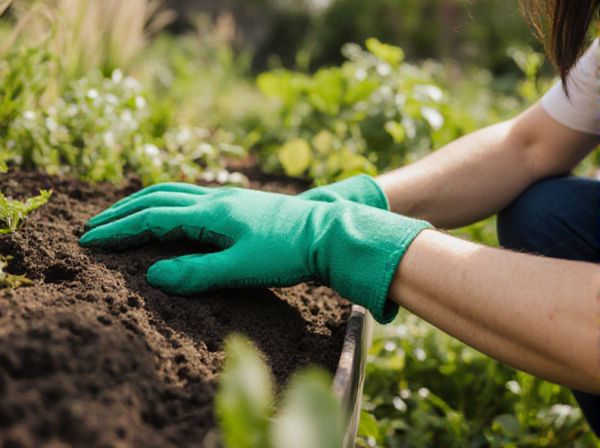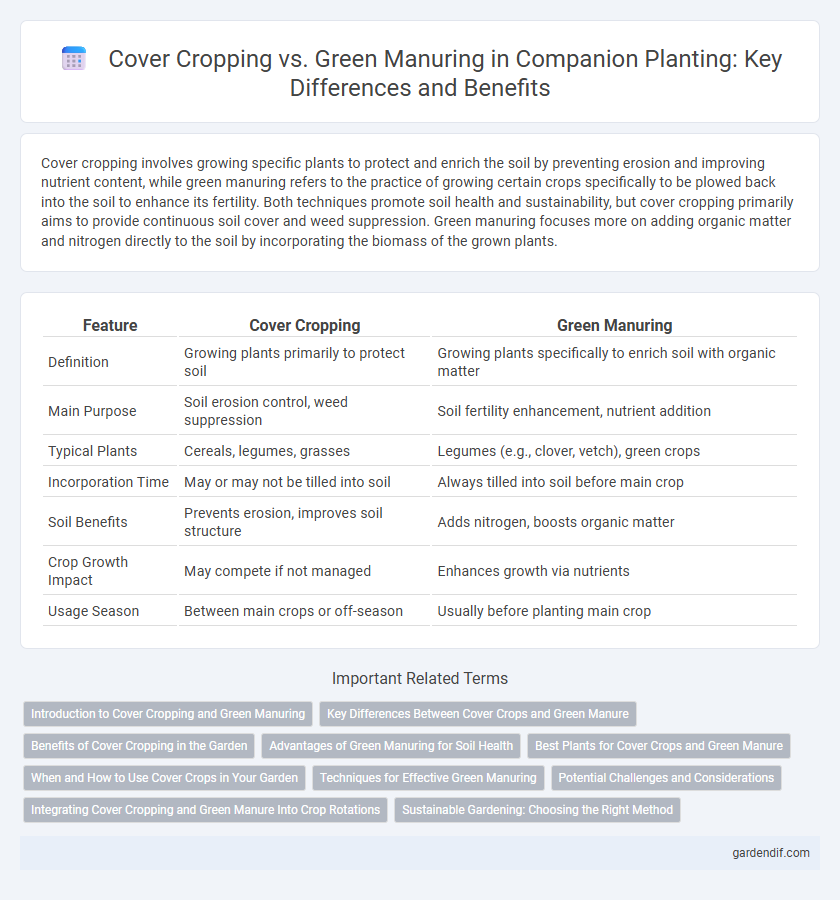
Cover cropping vs green manuring Illustration
Cover cropping involves growing specific plants to protect and enrich the soil by preventing erosion and improving nutrient content, while green manuring refers to the practice of growing certain crops specifically to be plowed back into the soil to enhance its fertility. Both techniques promote soil health and sustainability, but cover cropping primarily aims to provide continuous soil cover and weed suppression. Green manuring focuses more on adding organic matter and nitrogen directly to the soil by incorporating the biomass of the grown plants.
Table of Comparison
| Feature | Cover Cropping | Green Manuring |
|---|---|---|
| Definition | Growing plants primarily to protect soil | Growing plants specifically to enrich soil with organic matter |
| Main Purpose | Soil erosion control, weed suppression | Soil fertility enhancement, nutrient addition |
| Typical Plants | Cereals, legumes, grasses | Legumes (e.g., clover, vetch), green crops |
| Incorporation Time | May or may not be tilled into soil | Always tilled into soil before main crop |
| Soil Benefits | Prevents erosion, improves soil structure | Adds nitrogen, boosts organic matter |
| Crop Growth Impact | May compete if not managed | Enhances growth via nutrients |
| Usage Season | Between main crops or off-season | Usually before planting main crop |
Introduction to Cover Cropping and Green Manuring
Cover cropping involves planting specific crops like clover, rye, or vetch to protect and enhance soil health between main crop cycles, increasing organic matter and reducing erosion. Green manuring refers to growing these crops primarily to be incorporated into the soil while still green, enriching nutrient content and improving soil structure through rapid decomposition. Both practices play crucial roles in sustainable agriculture by boosting soil fertility, moisture retention, and microbial activity.
Key Differences Between Cover Crops and Green Manure
Cover cropping involves planting specific crops to protect and enhance soil health, providing benefits such as erosion control, weed suppression, and moisture retention throughout the growing season. Green manuring consists of growing certain plants, typically legumes or grasses, which are subsequently incorporated into the soil to improve organic matter content and nutrient availability, especially nitrogen fixation. The key difference lies in cover crops being maintained during the crop cycle for soil coverage, whereas green manure crops are grown primarily for soil amendment by tilling them into the soil at a specific growth stage.
Benefits of Cover Cropping in the Garden
Cover cropping enhances soil health by increasing organic matter and improving nutrient cycling, which supports robust plant growth in the garden. It suppresses weeds naturally by providing ground cover and limiting sunlight exposure, reducing the need for chemical herbicides. Cover crops also prevent soil erosion and improve moisture retention, creating an optimal environment for companion plants to thrive.
Advantages of Green Manuring for Soil Health
Green manuring enhances soil health by enriching organic matter and increasing nitrogen content through the incorporation of leguminous crops. It improves soil structure, promotes microbial activity, and boosts nutrient availability, leading to more fertile and resilient soil. This method also helps suppress weeds and reduces soil erosion, supporting sustainable agricultural practices.
Best Plants for Cover Crops and Green Manure
Cover cropping and green manuring both enhance soil fertility, but selecting the best plants depends on your goals and climate. Legumes like clover, vetch, and peas fix nitrogen effectively, making them excellent for green manure. Grasses such as rye, oats, and barley provide superior weed suppression and organic matter when used as cover crops.
When and How to Use Cover Crops in Your Garden
Cover crops are planted during off-seasons to protect soil, reduce erosion, and improve fertility by fixing nitrogen and adding organic matter. Use cover crops such as clover or rye after harvesting main crops, allowing them to grow until just before the next planting to maximize soil health benefits. Green manuring involves incorporating these crops into the soil, enhancing nutrient availability and structure for subsequent plantings.
Techniques for Effective Green Manuring
Green manuring involves growing specific cover crops such as legumes, mustard, and buckwheat that are later incorporated into the soil to enhance nutrient content and improve soil structure. Effective techniques include timely incorporation of green manure crops before flowering to maximize nitrogen fixation and organic matter addition, and choosing species based on soil type and cropping schedule for optimal biomass production. Regularly assessing soil health and adjusting green manuring practices can significantly boost soil fertility and crop yields.
Potential Challenges and Considerations
Cover cropping and green manuring both improve soil health, but cover crops may compete with primary crops for water and nutrients if improperly managed. Green manuring requires careful timing to ensure biomass is incorporated before planting, avoiding delays in crop growth. Both practices demand consideration of local climate, soil type, and crop compatibility to maximize benefits and minimize risks.
Integrating Cover Cropping and Green Manure Into Crop Rotations
Integrating cover cropping and green manuring into crop rotations enhances soil health by increasing organic matter and nutrient availability, particularly nitrogen fixation from legumes used in green manure. Diverse cover crops, such as rye, clover, or vetch, protect against erosion while suppressing weeds and improving soil structure, which supports subsequent main crops. Regularly alternating cover crops with green manures optimizes nutrient cycling and maintains a balanced microbial ecosystem, fostering sustainable agricultural productivity.
Sustainable Gardening: Choosing the Right Method
Cover cropping enhances soil health by reducing erosion, increasing organic matter, and promoting beneficial microbial activity. Green manuring involves growing specific plants to be tilled back into the soil, providing rapid nutrient release and improving soil fertility. Selecting between cover cropping and green manuring depends on garden goals, crop rotation plans, and local soil conditions for optimal sustainable gardening practices.
Cover cropping vs green manuring Infographic

 gardendif.com
gardendif.com